ANALYTICS
Advanced System Monitoring & Analytics for Smart Grids
Discover Real time edge control and AI for tomorrows smart grid services
Scope
Advanced system monitoring and analytics solution enhanced with intelligent interoperable data-driven features for efficient big data real-time analysis, failure diagnosis, automated management, and integrated micro-grid control
Future grids will include a large share of distributed and fluctuating renewable energy sources. They will be digitally-enhanced to enable the necessary observability and control of underlying distributed energy resource (DER) assets. A significant challenge in the scope of decarbonizing the power sector and aligning with future energy needs is ensuring seamless DER integration such as solar PV and battery storage systems in electrical networks through advanced management and control systems.
Therefore, we are entering an era whereby the energy focus is to improve PV’s performance and accelerate its advancement with new developments that facilitate fully dispatchable generation with storage. An industrial requirement is created for advanced, robust, and cost-effective system monitoring and control, as highlighted by the Solar Europe Industry Initiative (SEII) for enabling the transition towards a renewable grid.
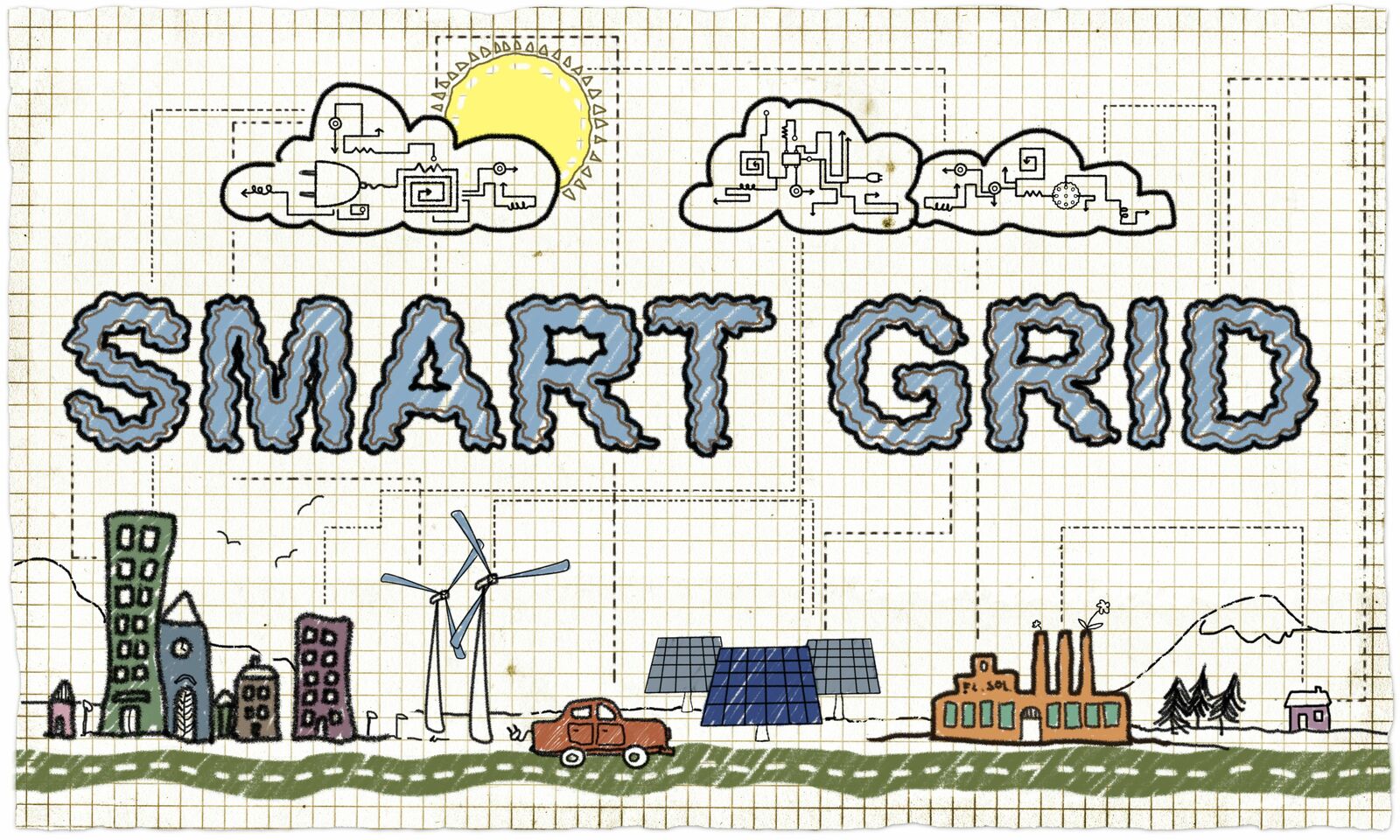
Benefits
The objective is to increase the value and competence of wind, solar, and energy storage by developing a next-generation multi-service monitoring and control system that:
- Increases system efficiency,
- Decreases investment cost through optimal performance,
- Provides communicative smart grid control services.
The smart monitoring and cloud-based control system will be developed by integrating advanced data analysis algorithms in an edge computing solution with cloud-connectivity. Implementing intelligent, automated, and interoperable data-driven features allow for efficient real-time analysis of big data, predictive failure diagnosis, operational management, and integrated smart grid control. Such features will reduce the Levelized Cost of Electricity (LCoE) by increasing the lifetime output, improving operational efficiency, and optimizing system operations. Therefore, the system will significantly impact the technology’s value chain and serve as a transitional step towards fully dispatchable renewable energy generation.
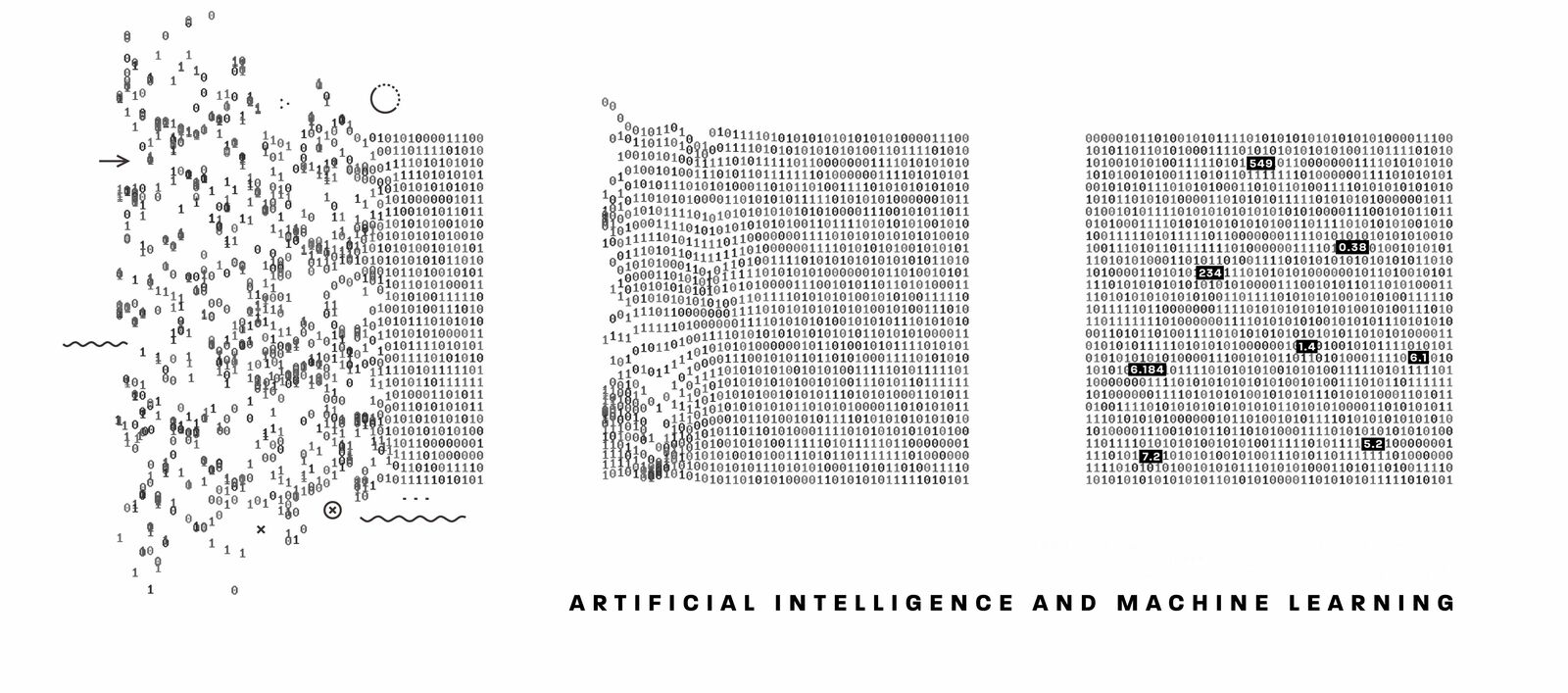
Approach
The approach of the research project is to:
- Assess data aggregation and interoperability protocols
- Formulate protocols and guidelines for interoperable smart-grid controls
- Develop predictive O&M diagnosis failure algorithms and asset reliability models incorporated as software modules to the advanced system
- Optimize PV-plus-storage performance by developing peak performing replicas (digital twins)
- Demonstrate the optimal performance of digital twins and software-based flexible power plant controllers at smart grid frequencies
The smart monitoring and cloud-based control system will be integrated with next-generation O&M, breakthrough supervision services (e.g., cost-effective predictive O&M, performance loss & failure predictions, and reliability routines), and advanced grid-to-storage applications that operate on data acquired from a vast integral of equipment (i.e., storage & grid controls) and tools (i.e., weather forecasts, workflows, and asset alerts).
Are you interested in technology building blocks or first-hand Pilot project demonstration results on our platform?
Drop us an email and we can schedule a demo.
The Main Project Activities
- Guidelines for the acquisition and analysis of renewable performance datasets
- HW and SW requirements for plant digitalization and energy flow management
- Accurate performance models for battery storage systems
- Software modules to forecast/diagnose failures and trend-based losses
- Reliability models for predicting equipment breakdowns
- nteroperable communication for integrated operation and data aggregation
- Cloud-based solution with enhanced energy management interoperability
- Digital twin and software-based controller with real-time frequency response on the edge
Technology Enablers
The activities of the research project are divided into eight work-packages (WPs)
Real-time edge computing
Scalable time-series data backend
Advanced Analytics
Machine learning
API, Open protocols and interfaces
Low-cost IoT Solutions
Real-world use cases
Financial performance & Risk classification
Real-time edge computing
Scalable time-series data backend
Advanced Analytics
Machine learning
API, Open protocols and interfaces
Low-cost IoT Solutions
Real-world use cases
Financial performance & Risk classification
Gain new insights on real time edge control and AI for tomorrows smart grid and asset services.
Latests Results
Result 1:
Microgrid setup at University Campus in Cyprus
- Commercial-scale microgrid real-time supervisory and control management dashboard
- Interoperable interfaces for real-time information flows for all underlying microgrid assets (building management systems, smart meters, storage and solar photovoltaic systems)
- Energy management system presenting in real-time (at 1Hz resolution) all main consumption/production and power quality parameters
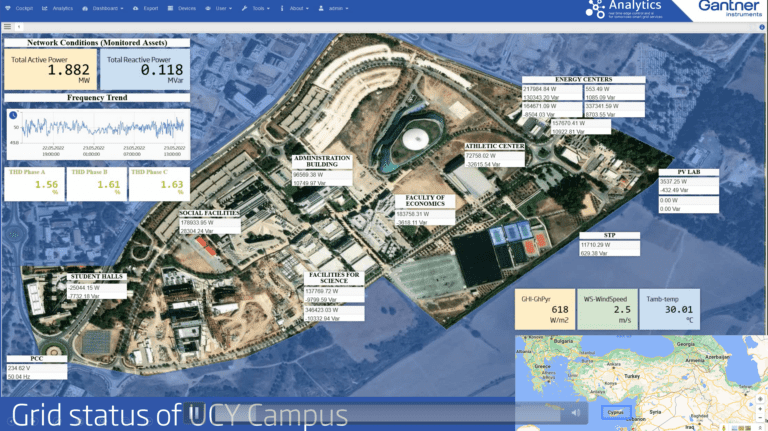
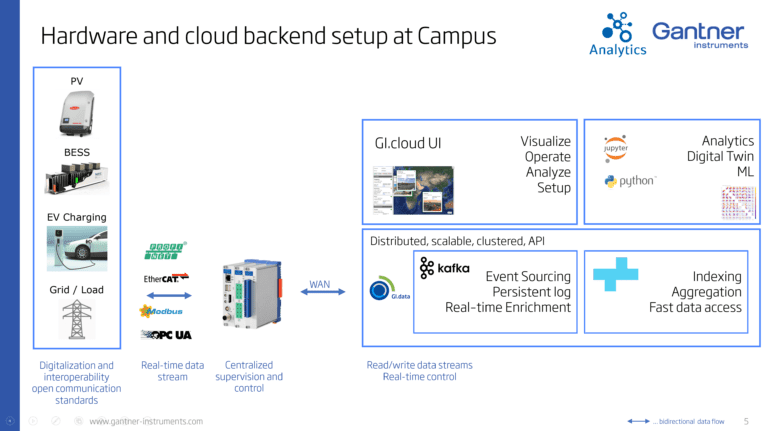
Result 2:
Hardware and cloud backend setup at University of Cyprus Campus
- Full interoperability demonstration using Modbus TCP communication protocol
- Integrated assets include building management systems, smart meters, photovoltaic inverters, battery storage systems and weather stations
Result 3:
Digital twin approach for PV fault diagnostics and health-state monitoring.
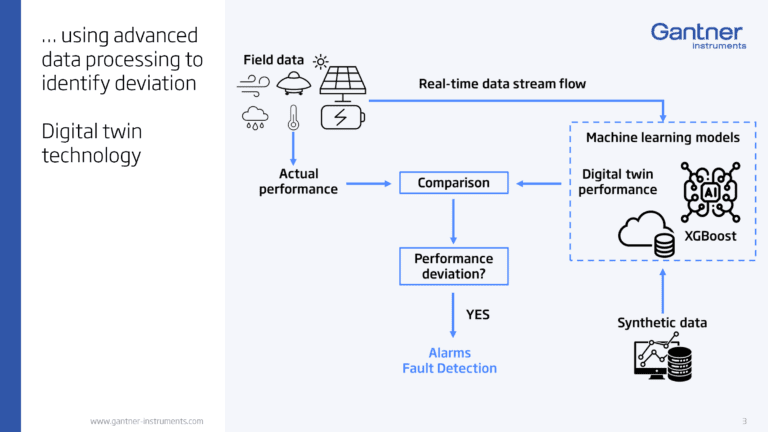
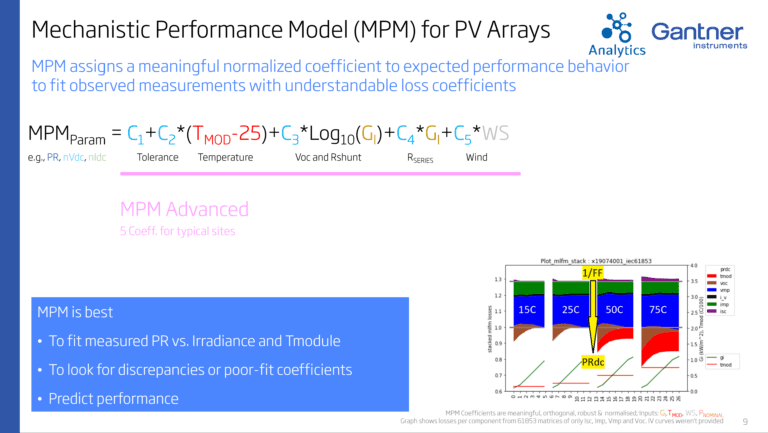
Result 4:
Mechanistic Performance Model (MPM) for PV Arrays
- MPM assigns a meaningful normalized coefficient to expected performance behaviorto fit observed measurements with understandable loss coefficients
Result 5:
Mechanistic Performance Model part of Gantner’s Monitoring and control platform
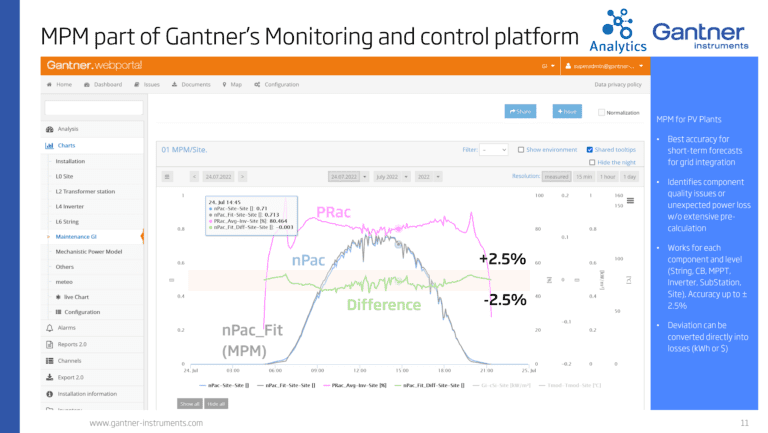
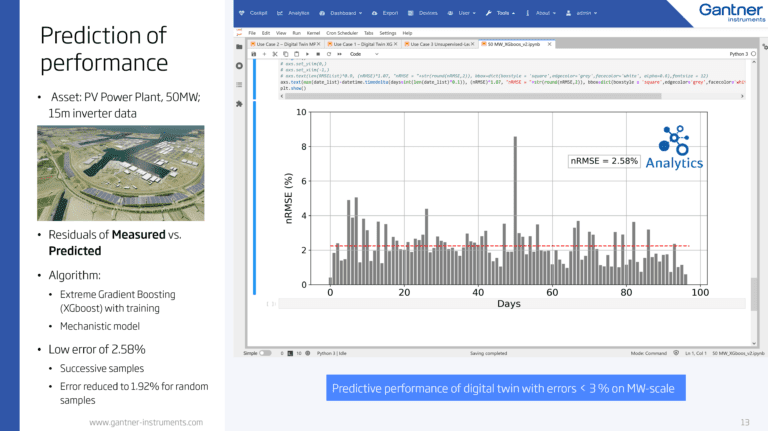
Result 6:
Predictive performance of digital twin with errors < 3 % on MW-scale
- Digital twin predictive models leveraging both mechanistic and machine learning principles (Artificial Neural Networks and Extreme Gradient Boosting)
- Site-specific modelling with fully optimized hyper-parameter definition implementation stages
Result 7:
Unsupervised-Learning Methods for outlier classification at MW-scale & Microgrids
- Unsupervised machine learning regimes (e.g., k-Nearest Neighbors, Angle-based Outlier Detector ) applied to data in order to detect and classify outliers (faults)
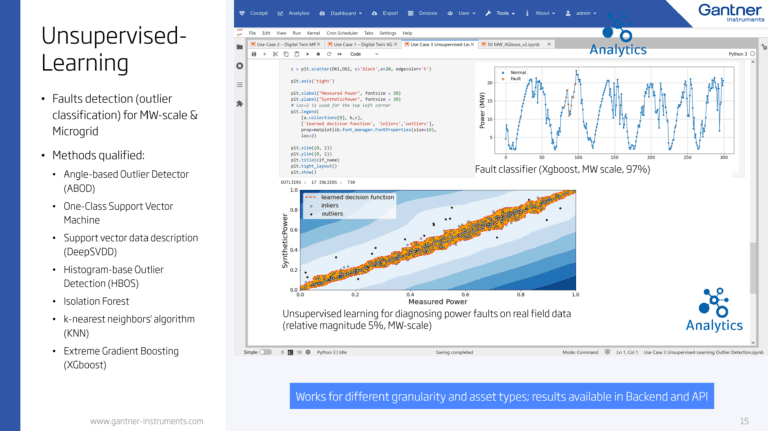
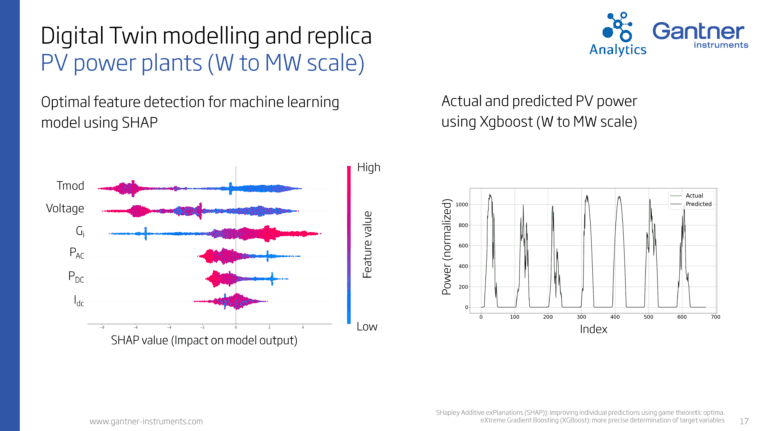
Result 8:
Digital Twin modelling and replica
- Fully validated, robust and replicable models from small-scale to utility-scale PV power plant
Result 9:
PV system deviation modelling
- PV system degradation rate calculation, short and long-term including (RdTools)
- Performance loss rate modeling and detection of performance inflection points (long-term performance deviations)
- Data quality, processing and sanity verification modeling for solar photovoltaic analytics

Workshop / Publications
“Data processing and quality verification for improved photovoltaic performance and reliability analytics,” Progress in Photovoltaics, DOI:10.1002/pip.3349, 2020 (Paper)
Intelligent cloud-based monitoring and control digital twin for photovoltaic power plants, 49th IEEE Photovoltaic Specialists Conference (IEEE PVSC 49), Philadelphia, USA, 2022 (Paper)
Intelligent cloud-based monitoring and control digital twin for photovoltaic power plants, 49th IEEE Photovoltaic Specialists Conference (IEEE PVSC 49), Philadelphia, USA, 2022 (Presentation)
Advanced system monitoring and artificial intelligent data-driven analytics to serve GW-scale photovoltaic power plant requirements, PV Performance Modelling Collaborative, Salt Lake City, USA, 2022 (Presentation, Video)
Unified methodology for PV data processing, quality verification, Web announcement of novel project results related to data quality and advance monitoring of PV power plants, PV magazine International, 2020 (Article)
PV Module Monitoring and Characterization, From data to insights across the PV technology development cycle, SUPSI PVLab Industry Day, 2021 (Presentation)
Improving Analysis Methods for IEC 61883 Matrix Measurements, PV Performance Modelling Collaborative, Salt Lake City, USA, 2022 (Poster)
Advanced health-state data analytic workflow for utility-scale photovoltaic power plants, IEEE 50th Photovoltaics Specialists Conference (PVSC), San Juan, Puerto Rico, 2023 (Paper)
Advanced data-driven solar analytics and streamlined workflows for utility-scale plants, 40th European Photovoltaic Solar Energy Conference & Exhibition
(EU PVSEC), Lisbon, Portugal, September 2023 (Paper)
Exchange of Experiences (SOLAR Cofund 2, CSP ERANET and CETPartnership), Session: Operation and diagnosis of PV plants; Project presentation, Results and Lessons learned (Presentation)
Latest Innovations in Predictive Analytics for Efficient Failure Diagnosis in Utility-Scale Photovoltaic Power Plants”, PV Performance Modelling Collaborative, Lugano, Switzerland, 2023 (Presentation)





The project PV-ANALYTIC is supported under the umbrella of SOLAR-ERA.NET Cofund 2 by the Austrian Research Promotion Agency (FFG) and the Research and Innovation Foundation (RIF) of Cyprus (P2P/SOLAR/0818/0012). SOLAR-ERA.NET is supported by the European Commission within the EU Framework Programme for Research and Innovation HORIZON 2020 (Cofund 2 ERA-NET Action, No 786483).